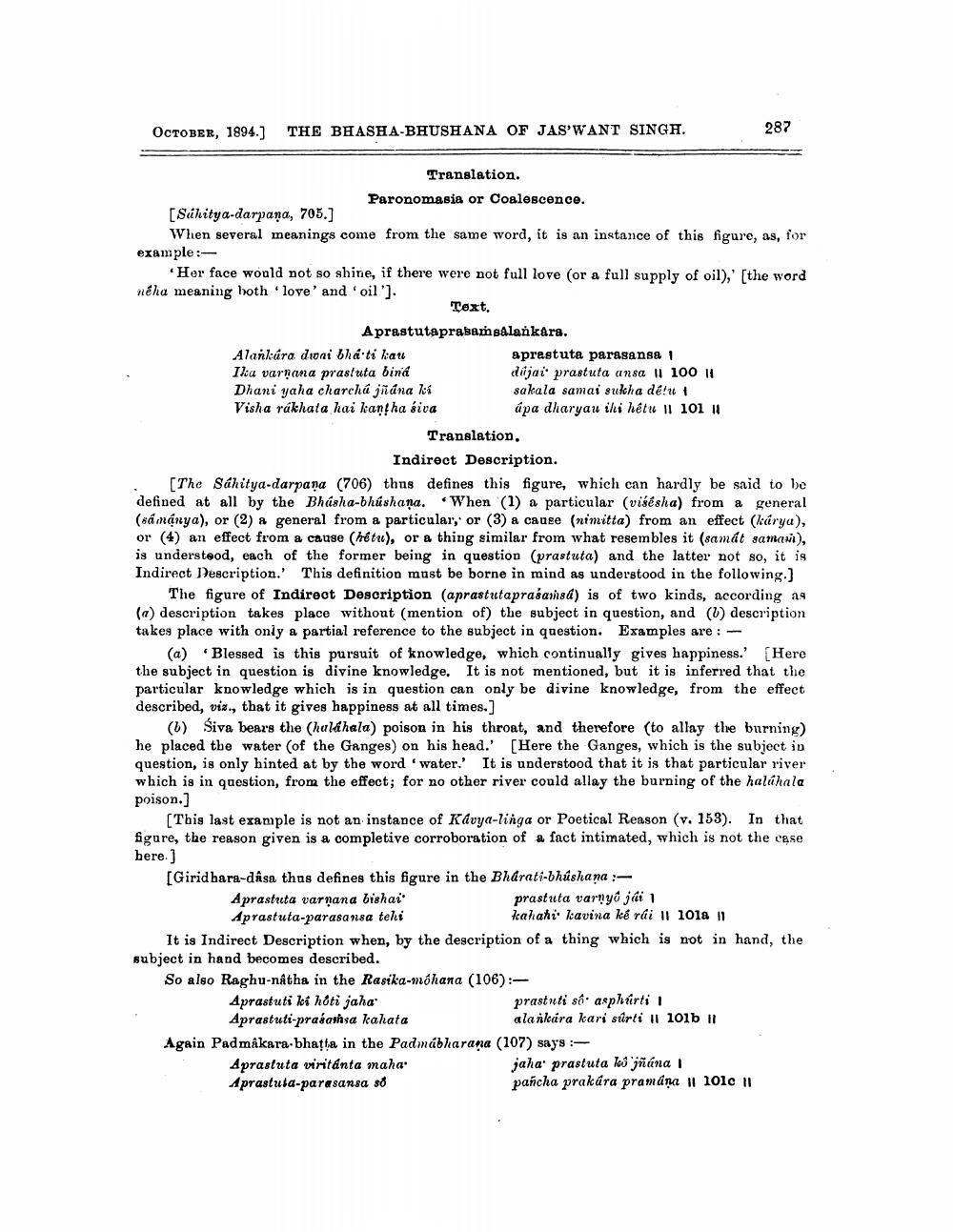________________
OCTOBER, 1894.] THE BHASHA-BHUSHANA OF JAS'WANT SINGH.
287
Translation.
Paronomasia or Coalescence. [Sahitya-darpana, 705.]
When several meanings come from the same word, it is an instance of this figure, as, for example:
Her face would not so shine, if there were not full love (or a full supply of oil),' [the word néha meaning both love' and 'oil').
Text.
A prastutaprabamgalankara. Alankára dwai bhd ti kau
aprestuta parasansa 1 Ika varnana prastuta bina
dijai prastuta ansa | 100 11 Dhani yaha charchú jiúna ki
sakala samai sucha délut Visha rákhata hai kantha siva
ápa dharyau iki hétre 11 101 !! Translation.
Indirect Description. The Sahitya-darpana (706) thus defines this figure, which can hardly be said to be defined at all by the Bhasha-bhúshana. "When (1) a particular (visesha) from a general (sa menya), or (2) a general from a particular, or (3) a cause (nimitta) from an effect (kúrya), or (4) an effect from a cause (hétu), or a thing similar from what resembles it (samát saman, is understood, each of the former being in question (prastuta) and the latter not so, it is Indirect Description. This definition must be borne in mind as understood in the following.)
The figure of Indirect Description (aprastutaprasarisd) is of two kinds, according a (a) description takes place without (mention of) the subject in question, and (1) description takes place with only a partial reference to the subject in question. Examples are: -
(a) Blessed is this pursuit of knowledge, which continually gives happiness. Here the subject in question is divine knowledge. It is not mentioned, but it is inferred that the particular knowledge which is in question can only be divine knowledge, from the effect described, vis., that it gives happiness at all times.]
(6) Siva bear's the (haldhala) poison in his throat, and therefore (to allay the burning) he placed the water (of the Ganges) on his head.' [Here the Ganges, which is the subject in question, is only hinted at by the word 'water.' It is understood that it is that particular river which is in question, from the effect; for no other river could allay the burning of the haláhala poison.]
[This last example is not an instance of Kavya-linga or Poetical Reason (v. 153). In that figure, the reason given is a completive corroboration of a fact intimated, which is not the case here.) [Giridhara-dîsa thus defines this figure in the Bharati-bhúshana :Aprastuta varnana bishai
prastuta varnyő jái 1 Aprastuta-parasansa teki
Hahahi' kavina ké rái | 1018 11 It is Indirect Description when, by the description of a thing which is not in hand, the subject in hand becomes described. So algo Raghu-nátha in the Rasika-mohana (106) :Aprastuti ki hoti jaha
prastuti so. asphtirti 1 Aprastuti-prašansa kahata
alankára kari súrli Il 101b 11 Again Padmakara-bhatta in the Padmábharana (107) says :Aprastuta viritanta maha
jaha: prastuta ko jñána Aprastuta-parasansa sổ
pancha prakára pramana 11 1010 11




